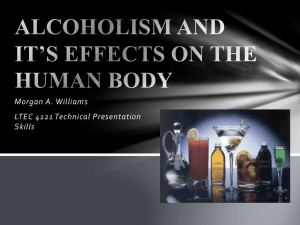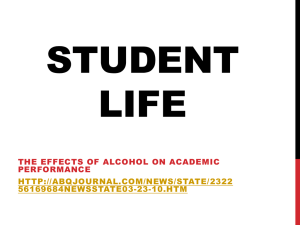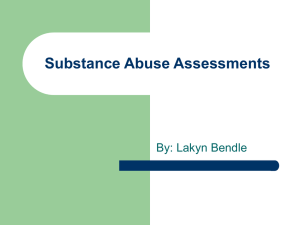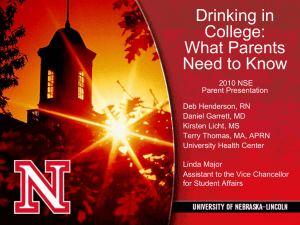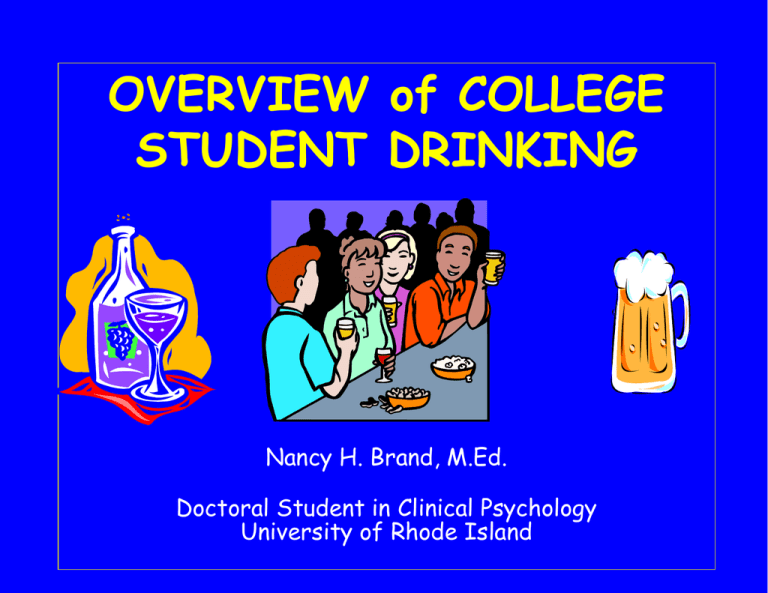
OVERVIEW of COLLEGE
STUDENT DRINKING
Nancy H. Brand, M.Ed.
Doctoral Student in Clinical Psychology
University of Rhode Island
“College Students”
defined herein as full-time
students between the ages of
18-24 attending 2 or 4-year
colleges or universities
SCOPE OF THE PROBLEM
• Nationwide, 44% of college students engage
in heavy episodic drinking or “binge” drinking
defined as:
MEN: as 5 or more drinks in a row over the
past 2 weeks
WOMEN: 4 or more drinks in a row over the
past 2 weeks
• Since 1980, estimates of heavy drinking
have remained stable between 40-45
percent of college students.
• College students drink more than than same
age noncollege peers
(source: www.collegedrinkingprevention.gov)
JUST WHO ARE
WE TALKING
ABOUT HERE??
Heaviest Drinkers tend to be:
• Males
• whites
• members of fraternities and
sororities
• athletes
• first-year students
(source: www.collegedrinkingprevention.gov)
Students who drink the
least are likely to attend:
• 2-year institutions
• religious schools
• commuter schools
• historically Black colleges and
universities
source: www.collegedrinkingprevention.gov)
INDIVIDUAL FACTORS
AFFECTING DRINKING
BEHAVIOR
• Genetic and biological predisposition to use alcohol
• Family history of alcohol and drug use
• Personality factors (e.g., sensation seeking and
impulsivity)
• Belief systems (e.g. you can’t have fun without
alcohol)
• Expectations about the Effects of Alcohol (e.g.,
drinking will make me more sociable and attractive
to others)
(source: www.collegedrinkingprevention.gov)
ENVIRONMENTAL
FACTORS AFFECTING
DRINKING BEHAVIOR
• Geographical Location
• Size of student body
• Importance of Athletics on Campus
• Availability of Alcohol in surrounding
community
(source: www.collegedrinkingprevention.gov)
SO WHAT!
WHAT’S THE BIG
DEAL??
THE U.S. SURGEON GENERAL AND THE DEPT. OF
HEALTH AND HUMAN SERVICES HAVE DECLARED
THAT HEAVY DRINKING IS THE NUMBER ONE HEALTH
PROBLEM AFFECTING COLLEGE STUDENTS
(source: www.collegedrinkingprevention.gov)
Alcohol-Related Consequences
• DEATH: 1400 college students die in alcoholrelated accidents a year
• ASSAULT: 600,000 students are assaulted by
others who are under the influence of alcohol
• INJURY: 500,000 students are unintentionally
injured because of heavy drinking
• SEXUAL ABUSE: 70,000 students are victims
of alcohol-related sexual assault or date rape
(source: www.collegedrinkingprevention.gov)
Alcohol-Related Consequences (cont.)
•Academic Performance: 25% report
academic consequences as a result of drinking
such as missing class, performing poorly on
exams and papers, and falling behind
•Health problems: 150,000 develop health
related problems
•Unsafe sex: 400,000 students had
unprotected sex and more than 100,000
students reported being too drunk to know if
they consented to sex
(source: www.collegedrinkingprevention.gov)
APPROXIMATELY 55% of STUDENTS
WHO ABSTAIN or DRINK IN
MODERATION ARE AFFECTED BY
SOMEONE ELSE’S DRINKING such as:
•
being humiliated or assaulted
•
having property damaged
•
experiencing unwanted sexual advance
(source: www.collegedrinkingprevention.gov)
SO WHAT’S BEING ABOUT
THIS?
THE NATIONAL INSTITUTE ON ALCOHOL
ABUSE and ALCOHOLISM (NIAAA) TASK
FORCE ON COLLEGE STUDENT DRINKING
EMPHASIZES THE NEED TO CHANGE THE
CULTURE OF COLLEGE STUDENT DRINKING BY
TARGETING:
1. The college and it’s surrounding community
2. The student population as a whole
3. Individuals, including at-risk or alcoholdependent drinkers
(source: www.collegedrinkingprevention.gov)
PROMISING INTERVENTIONS:
The college and its surrounding
community (environmental strategies)
• Provide Alcohol-free options for
recreational, social and cultural events
and venues
• Restrict alcohol availability and
advertising on and off-campus
• Social Norms Correction
• Develop and enforce campus policies and
and local, state and federal laws
(source: DeJong & Langford, 2002)
PROMISING INTERVENTIONS:
GROUP and INDIVIDUAL SESSIONS
• Expectancy challenge procedures
• Brief motivational feedback
interviews
• Alcohol skills training
(source: DeJong & Langford, 2002)
LESS EFFECTIVE INTERVENTIONS
• Standard Alcohol Awareness
Education Programs (e.g., alcohol
awareness weeks, freshman
orientation, and curriculum infusion
where faculty introduce alcoholrelated factors and issues into
courses)
• Values Clarification Programs
RATIONALE:
Harm reduction (vs. abstinence)
• Strategies to encourage students to drink in moderation
in order to avoid the consequences of risky drinking
• In other words, help students enjoy the good things
about drinking (socializing, having fun) while avoiding the
bad things about drinking (hangovers, DUIs, unplanned
sex)
WHAT CONSTITUTES
MODERATE DRINKING?
BLOOD ALCOHOL LEVELS (BAL) < .055
(legal driving limit (.08) in most states)
Biphasic effect of Alcohol:
Stimulating effects up to .055 (approximately 1-2 drinks
for women and 2-3 for men over several hours depending
on weight) . Most people report feeling relaxed and happy
at these levels.
Depressant effects beyond .055 (3 or more and 4 or more
for men depending on weight). These lead to impaired
judgement, motor coordination, as well as hangovers and
other unwanted consequences
Biphasic effect of Alcohol
•Happy
•Outgoing
•Energetic
.055
BAL levels
Feelings/effects
>.10
.055
•Hangovers
•Missing class or
work
•Sex w/ scary
people
BAL(F)
BAL(M)
MODERATION
YOU AVOID:
YOU GAIN:
•hangovers
• Save $$
•embarrassment
• maintain control
•weight gain
• maintain desired
academic
performance
•pressure from family/schoo
about grades
•long-term health
consequences
•tolerance and heavy drinking
•regrettable sexual
encounters
• Maintain healthy
relationships with
others
STRATEGIES FOR MODERATED DRINKING
• Eat before drinking (can cut BAL’s up to
50%!!
• Space your drinks
• Alternate alcoholic drinks w/ non-alcoholic
drinks
• avoid drinking games
• experiment with drinking less and refusing
drinks
• drink reduced alcohol beer instead of
stronger spirits
• drink slower
FACT or MYTH:
Heavy drinking is the norm on
most college campuses
Believe it or not….
Moderate drinking is the norm on nearly all campuses!!!
(55-60% of college students drink in moderation.
• The average female college student drinks 5/week
• The average male college student drinks 10/week.
IN both cases, BAL levels are about .05 per week.
FURTHERMORE, students drinking in these ranges report
very few-- if any alcohol related consequences!
PART 2:
HOW TO EVALUATE
THIS INFORMATION
WHEN IT SEEMS
LUDICROUS

